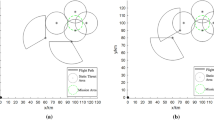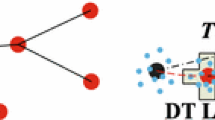Abstract
This paper presents a new computationally efficient S&A algorithm for implementation in real-time applications for UAV. Based on a simplified optimisation approach, the proposed algorithm aims to provide a reliable resolution manoeuvre (horizontal and vertical) for multiple threat scenarios which include both air and ground threats/obstacles. In presence of a conflict risk, the avoidance manoeuvre is defined as step variation in the heading angle or altitude variation of the autopilots command. This step command is optimised in order to keep a minimum distance of separation between the ownship and all threats during the overall manoeuvre. The algorithm computes the separation distance between the UAV and the threats by calculating the future trajectories at each time step of both the ownship and the threat, while always taking into account the ownship performance envelope constraints. The algorithms were validated in simulation, where the ground threats were derived from the ground elevation maps, while for the aerial threats the aircraft communicate their flight data through an ADS-B mode S transponder. The resolution manoeuvre optimisation technique takes about 0.1 second to compute. Hence enabling the algorithm to cope with any rapid changes in the aerial threat trajectory.
Similar content being viewed by others
References
Albaker, B., Rahim, N.: A survey of collision avoidance approaches for unmanned aerial vehicles. In: technical postgraduates (TECHPOS), 2009 international conference for, pp. 1–7. doi:10.1109/TECHPOS.2009.5412074 (2009)
Bureau ATS: Limitations of the See-and-Avoid Principle. PO Box 967, Civic Square ACT 2608, reprint (2004)
Center ERSDA. Aster global digital elevation model. Available at: http://www.gdem.aster.ersdac.or.jp/index.jsp (accessed 96th October 2010) (2009)
Chryssanthacopoulos, J. P., Kochenderfer, M. J., Williams, R. E.: Improved monte carlo sampling for conflict probability estimation. In: 51st AIAA/ASME/ASCE/AHS/ASC Structures, Structural Dynamics, and Materials Conference, Orlando, FL (2010)
Gangul, A., Avadhanam, S.: On the limits of collision detection performance of a sense-and-avoid system for non-cooperative air traffic. In: AIAA Infotech@Aerospace, 2010, Atlanta, GA (2010)
Gawron, V. J.: Human factors issues in the development, evaluation, and operation of uninhabited aerial vehicles. In: AUVSI ’98: Proceedings of the Association for Unmanned Vehicle Systems International, Huntsville, AL (1998)
Kandil, A., Wagner, A., Gotta, A., Badreddin, E.: Collision avoidance in a recursive nested behaviour control structure for unmanned aerial vehicles. In: Systems Man and Cybernetics (SMC), 2010 IEEE International Conference on, pp 4276–4281 (2010). doi:10.1109/ICSMC.2010.5642396
Kochenderfer, M.J., Espindle, L.P., Kuchar, J.K., Griffith, J.D.: A bayesian approach to aircraft encounter modeling. In: AIAA Guidance, Navigation and Control Conference and Exhibit, Honolulu, HI (2008)
Kochenderfer, M.J., Griffith, J.D., Kuchar, J.K.: Hazard alerting using line-of-sight rate. In: AIAA Guidance, Navigation and Control Conference and Exhibit, Honolulu, HI (2008b)
Melega, M., Lazarus, S., Savvaris, A.: Autonomous collision avoidance based on aircraft performances estimation. In: Digital Avionics Systems Conference (DASC), 2011 IEEE/AIAA 30th, pp. 5B4–1–5B4–15 (2011). doi:10.1109/DASC.2011.6096077
Melega, M., Lazarus, S., Savvaris, A.: Sense & avoid algorithm based on aircraft performances estimation. In: CEAS 2011, The international Conference of the European Aerospace societies, pp. 5B4–1–5B4–15 (2011). doi:10.1109/DASC.2011.6096077
Melega, M., Lazarus, S., Lone, M., Savvaris, A.: Autonomous sense & avoid capabilities based on aircraft performances estimation. Proceedings of the institution of mechanical engineers. Part G: J. Aerosp. Eng. (2013). doi:10.1177/0954410012472603
Samekm, J., Sislak, D., Volf, P., Pechoucek, M.: Multi-party collision avoidance among unmanned aerial vehicles. In: Intelligent Agent Technology, 2007. IAT ’07. IEEE/WIC/ACM International Conference on, pp. 403 –406 (2007). doi:10.1109/IAT.2007.58
Shandy, S.U., Valasek, J.: Intelligent agent for aircraft collision avoidance. In: AIAA Guidance, Navigation, and Control Conference and Exhibit, Montreal, Canada (2001)
Shin, H.S., Tsourdos, A., White, B.A., Shanmugavel, M., Tahk, M.J.: Uav conflict detection and resolution for static and dynamic obstacles. In: AIAA Guidance, Navigation and Control Conference and Exhibit, Honolulu, HI (2008)
Sislak, D., Volf, P., Komenda, A., Samek, J., Pechoucek, M.: Agent-based multi-layer collision avoidance to unmanned aerial vehicles. In: Integration of Knowledge Intensive Multi-Agent Systems, 2007. KIMAS 2007. International Conference on, pp. 365 –370 (2007). doi:10.1109/KIMAS.2007.369837
Swihart, D. E., Brännström, B., Griffin, E., Rosengren, R., Doane, P.: Autonomous collision avoidance system for air-to-air operations. In: AIAA/ICAS International Air and Space Symposium and Exposition: The Next 100 Years, Dayton, OH (2003)
Volf, P., Sislak, D., Pechoucek, M., Prokopova, M.: Convergence of peer-to-peer collision avoidance among unmanned aerial vehicles. In: Intelligent Agent Technology, 2007. IAT ’07. IEEE/WIC/ACM International Conference on, pp. 377–383 (2007). doi:10.1109/IAT.2007.75
Zeitlin, A.D.: Developing requirements for the unmanned aircraft sense & avoid function. In: AIAA Infotech@Aerospace Conference, pp 2009–1924, Seattle, WA (2009)
Author information
Authors and Affiliations
Corresponding author
Rights and permissions
About this article
Cite this article
Melega, M., Lazarus, S., Savvaris, A. et al. Multiple Threats Sense and Avoid Algorithm for Static and Dynamic Obstacles. J Intell Robot Syst 77, 215–228 (2015). https://doi.org/10.1007/s10846-014-0073-2
Received:
Accepted:
Published:
Issue Date:
DOI: https://doi.org/10.1007/s10846-014-0073-2




